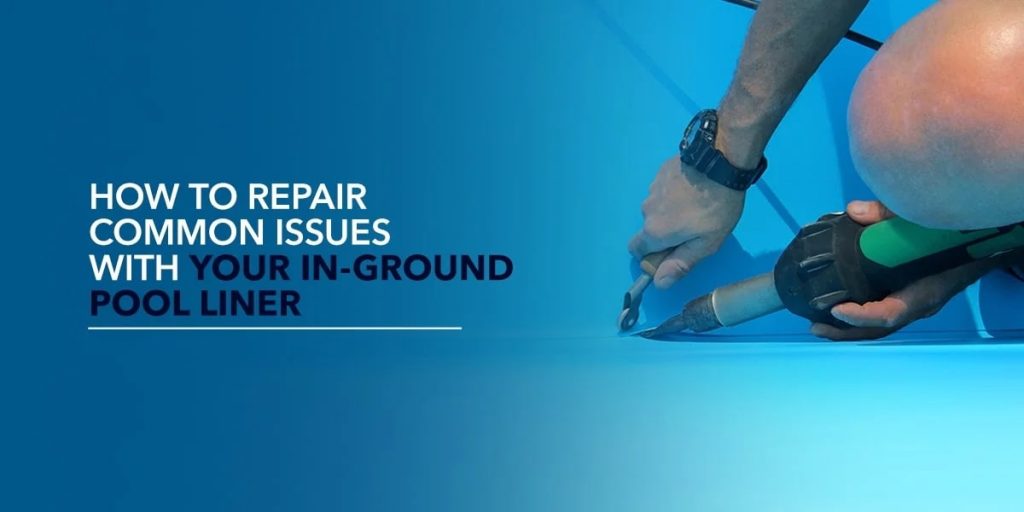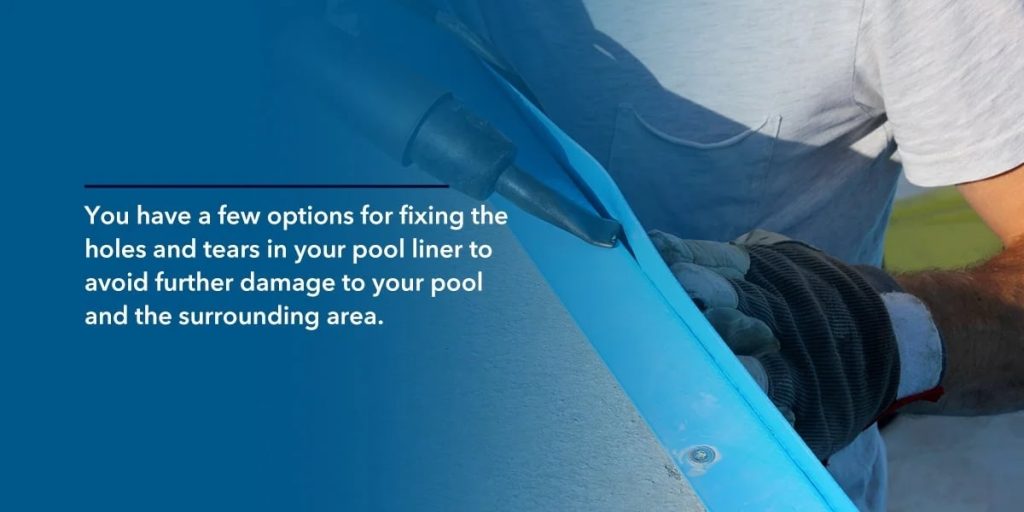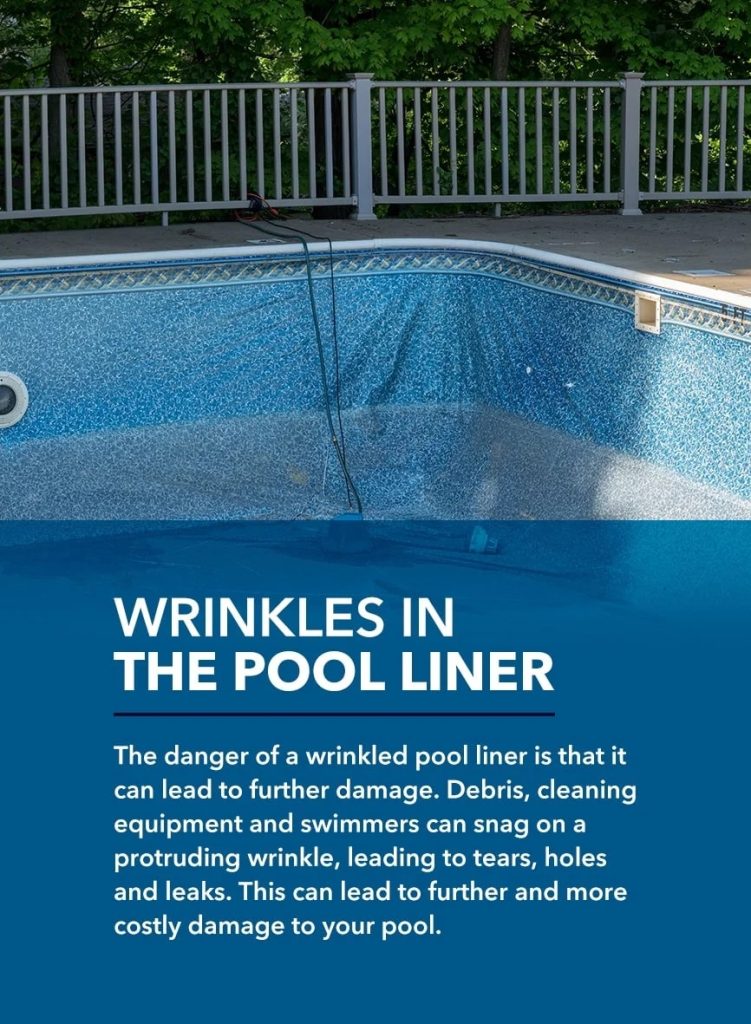

Every in-ground pool owner hopes their pool liner can last another season. If your pool liner has seen better days, take heart — there’s a good chance you can repair it so it can last a bit longer before needing a replacement. Repairs will be much more affordable and less time-consuming than a full-on replacement, but note that you may only be able to solve some issues with a brand-new liner.
In-ground pool liner repair can extend the life of your pool’s current liner. This article covers some of the most common issues that repairs may be able to fix. See if any of these issues relate to your situation, and get your pool ready for the upcoming season!
Pool liners can get tears and holes for many reasons. Foreign objects in the pool like rocks or sticks can cut into the liner, causing a hole. But sometimes, age may be the main reason why your pool liner is suffering damage. Old pool liners seem to get holes and tears for no reason at all. While you may have missed seeing the cause of the hole, it’s normal for old pool liners to suffer damage much more easily than new pool liners.
Tears and holes can lead to trapped water and air pockets. Left unattended, these can damage the area surrounding your pool, including cracks in the concrete and soil erosion. Your best bet is to resolve this issue before any worse problems arise.
The good news about tears and holes is that they’re usually easy to spot. Some other issues can feel like you’re trying to solve a mystery, and often you’ll need professional help to know exactly what is wrong with your pool liner. But pool liner repair can be easy when you’re dealing with tears and holes because they’re often at least several inches long. Plus, they can be quite the eyesore, encouraging pool liner repair as soon as possible.

You have a few options for fixing the holes and tears in your pool liner to avoid further damage to your pool and the surrounding area. You can use duct tape, waterproof tape or peel-and-stick patches over the hole with moderate success.
Using a vinyl pool liner repair patch kit is the best option. The success of the patch depends on the size of the hole. Smaller holes, which are only a few inches in length or diameter, are easier to repair, require less vinyl patching and have longer-lasting results. Larger holes, which can be several inches to over a foot long, demand more vinyl patching and tend to wear out more quickly.
Here are some steps for fixing your pool liner’s hole with a vinyl patch kit:
Fixing tears and holes can be easy and give you at least another season with your current pool liner. Note that if the overall condition of the liner is contributing to more tears and rips, it may be time — or almost time — to install a new in-ground pool liner.

Leaks often go hand-in-hand with tears and holes. A pool liner’s purpose is to provide a soft swimming area while holding the water within the pool. When your pool liner has a leak, water can escape from the contained area, leading to a damaged pool and more money spent on water continually refilling your pool.
One of the main differences between a leak and an actual hole or tear is its visibility. It can be difficult to find a leak in your pool or even know if your pool has a leak at all. If you think your pool may have a leak and you want to know for sure, try these three leak-finding methods:
You can fix a leaking pool liner the same way you repair a hole or tear. After locating the leak, one of the best solutions is to use a vinyl patch kit to cover it. Ideally, this will stop the water from leaking out and extend the life of your pool liner, especially if it is relatively new and in good shape overall.
Keep in mind that multiple patches can start to take a toll on your pool liner’s appearance. You may want to avoid having your pool liner look like a quilt of patches, so pool liner replacement may be the way to go after a while.
Floating pool liners appear as bubbles or bulges as if there were air behind the liner pushing it out. This is a result of hydrostatic pressure around the pool structure, which forces the liner to bubble up or float. An excess of groundwater around the pool is a major culprit for floating pool liners. That’s why pools in flood zones or lower elevations of the neighborhood are more prone to floating pool liners. Pool liners can also start bubbling and floating after heavy rainfall.
Unfortunately, once a floating pool liner starts floating, it may not go back to normal unless you do a full replacement. The most you can do is try to prevent your pool liner from floating to begin with, but even this can be a difficult task. Here are some suggestions to try to limit the occurrence of floating pool liners:
If you have a floating pool liner, you may want to consider calling a professional for help or to see if you need a replacement.

Wrinkles are highly noticeable ripples or waves in your pool liner. They’re similar to floating pool liners in their appearance, but they are often less “bubbly.” Wrinkles in a pool liner are like wrinkles in a blanket — narrow pieces of material that have pulled away or shifted in their position from the rest of the material. So, in a vinyl pool liner, a wrinkle appears as excess vinyl hanging or folding from the pool’s inside surface.
The danger of a wrinkled pool liner is that it can lead to further damage. Debris, cleaning equipment and swimmers can snag on a protruding wrinkle, leading to tears, holes and leaks. This can lead to further and more costly damage to your pool. And as time goes by, wrinkles can harden, becoming an obstacle in the pool that can impact the enjoyment of swimming in your pool.
A wrinkled pool liner is always disappointing to see, especially if your liner is relatively new. But old and new pool liners alike can experience wrinkles. There are two main reasons behind wrinkles in your pool liner, regardless of its age.
The first reason is the same as the cause behind floating pool liners — hydrostatic pressure. As this pressure builds up, it can force your pool liner to start bubbling out. In some instances, this can lead to more wrinkly results than the standard floating pool liner. Your best bet is to prevent this from happening by using the same measures listed in the previous section for floating pool liners.
The second reason has to do with your use of chlorine and other chemicals to keep your pool water clean. These chemicals are usually acidic, which means they have a pH lower than 7. Because of this, they can pull the moisture from your pool liner, causing it to shrivel up and wrinkle.
It’s impossible to prevent pool liners from experiencing chemical wrinkles completely, especially if your pool liner has a long life expectancy. But you can reduce your pool liner’s chances of experiencing a wrinkle by keeping your pool’s pH levels in check and using chlorine alternatives.
Every pool owner will one day face a situation where they need to decide if they should replace their pool liner. Your pool liner does a lot for your pool, from giving swimmers a great experience to making your pool look beautiful and inviting on a hot summer day. But a bad pool liner will have the opposite effect, making your pool sit there without getting any use.
Here are some examples of times when a new pool liner installation would be a good idea:
The issues listed throughout this article can be a lot to deal with by yourself. Experience peace of mind by letting the professionals at Lotus Pools repair and maintain your damaged pool liner or do a brand new pool liner installation. We specialize in in-ground pools of all shapes, sizes and types in the Chicago area, so you can be sure we’ll provide the best results possible for yours.
Schedule a service call today to take the next step toward giving your pool the care it deserves.